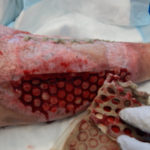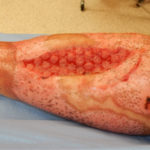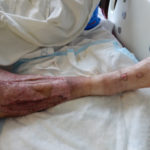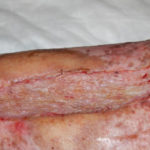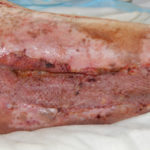
Sigrid Blome-Eberwein, MD, is the associate director at the Regional Burn Center in Allentown, Pennsylvania since 2002. She is a member of the VDPRAEC, an associate member of the ASPS, associate professor of surgery at the University of South Florida and a Burn/Plastic Surgeon at Lehigh Valley Hospital Network. After completion of a Burn fellowship at USC Los Angeles, California and a completed residency in plastic and reconstructive surgery at the University of Heidelberg, Germany, she joined the Lehigh Valley Hospital staff in the Burn unit in 2002. The Lehigh Valley Hospital Network Regional Burn Center treats approximately 200 pediatric and 500 adult acute Burn patients per year and is accredited by the ABA for pediatric and adult Burn care. In addition, Dr. Blome-Eberwein performs reconstructive procedures on both, pediatric and adult patients on an ongoing basis.
Blome-Eberwein_Current Dialogues in Wound Management_2018_Volume 4_Issue 2
NOTE: As with any case study, the results and outcomes should not be interpreted as a guarantee or warranty of similar results. Individual results may vary depending on the patient’s circumstances and condition.
BACKGROUND
The case presented here is that of an 80-year-old female found down for an unknown length of time. She was disoriented and had no recollection of any precipitating incident at the time of presentation. The patient was found by neighbors and was transferred and admitted to our hospital’s trauma service with blisters on her right leg, rhabdomyolysis and compartment syndrome of the right leg. Her past medical history included hypertension, demand ischemia and depression. She was also diagnosed with a T11 end plate fracture and unspecified encephalopathy.
TREATMENT
Initially, the patient was taken to the operating room for fasciotomy of the right leg. Necrotic tissue was suspected, but not clearly identified during this procedure. The wounds were dressed in wet-to-dry dressings. Eight days later the necrotic muscle began to demarcate, and she was taken back to the operating room for necrotic tissue debridement. Wet-to-dry dressings were continued. The burn service was then consulted for wound management with further debridement being performed and the application of a standard V.A.C.® Dressing (Figs. 1,2). Upon dressing change, further necrotic tissue was identified (Fig 3). Another surgical debridement was performed and the V.A.C. VERAFLO CLEANSE CHOICE™ Dressing was applied in order to facilitate further wound cleansing, antiseptic wound flushes and to stimulate rapid granulation tissue growth. At this point there was significant tissue loss in the lower leg and cavities that reached down to the tibia and fibula (Fig 4). The V.A.C. VERAFLO™ Therapy using V.A.C. ULTA™ Therapy Unit was set to -125 mmHg pressure with instillation every four hours and ten-minute dwell time. In our institution, we used mafenide acetate
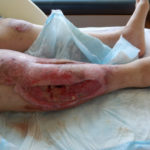 Figure 1: Leg wound after conventional V.A.C.® Therapy removal post 2x debridement POD 3
Figure 1: Leg wound after conventional V.A.C.® Therapy removal post 2x debridement POD 3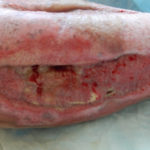 Figure 2: Close up of leg wound after conventional V.A.C.® Therapy removal post 2x debridement POD 3
Figure 2: Close up of leg wound after conventional V.A.C.® Therapy removal post 2x debridement POD 3
2.5% solution for the first six days, followed by Dakin’s Solution 0.025% as the instillation fluid. The V.A.C. VERAFLO CLEANSE CHOICE™ Dressing was changed every 3 days over the following 15 days, for a total of 4 times (fig 5,6). Seventeen days after initiation of V.A.C. VERAFLO CLEANSE CHOICE™ Dressing therapy, the wound was closed with split-thickness skin graft (STSG) and healed successfully (Figs. 7-11).After treatment and upon discharge, the patient was transferred to an assisted living facility after her wounds were closed and she has not presented back to our outpatient facility for breakdown or re-opening of her wounds, which now totals six months of follow up.
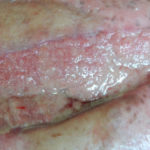 Figure 3: Exudate and pockets of deep necrotic tissue after 5 days of conventional V.A.C.® Therapy treatment
Figure 3: Exudate and pockets of deep necrotic tissue after 5 days of conventional V.A.C.® Therapy treatment
DISCUSSION
With our standard of care, we would have performed manual flush dressings with mafenide acetate and Dakin’s Solution in order to maintain antisepsis in this wound. Granulation tissue growth would have been much slower, based on previous experience with these types of wounds and an occlusive V.A.C. dressing placement would have been initiated only after the wound was completely free of any necrotic tissue elements.
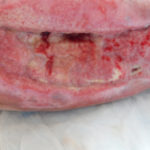 Figure 4: Exudate and pockets of deep necrotic tissue reaching bone after conventional V.A.C.® Therapy treatment
Figure 4: Exudate and pockets of deep necrotic tissue reaching bone after conventional V.A.C.® Therapy treatment
The utilization of V.A.C. VERAFLO™ Therapy and the V.A.C. VERAFLO CLEANSE CHOICE™ Dressing facilitated continuous wound cleansing and rapid granulation tissue growth which led to expedited wound closure in this complicated wound.

